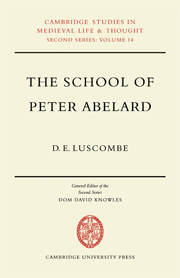Book contents
- Frontmatter
- Contents
- Preface
- List of Abbreviations
- I The Literary Evidence
- II Abelard's Followers
- III The Diffusion of Abelardian Writings
- IV The Condemnation of 1140
- V The Theological Writings of Abelard's Closest Disciples
- VI The School of Laon
- VII Hugh of St Victor
- VIII The Summa Sententiarum
- IX Abelard and the Decretum of Gratian
- X Abelard's Disciples and the School of St Victor
- XI Peter Lombard
- XII Robert of Melun
- XIII Richard of St Victor
- XIV Conclusion
- Appendices
- Bibliography
- Index of Manuscripts
- General Index
III - The Diffusion of Abelardian Writings
Published online by Cambridge University Press: 05 November 2011
- Frontmatter
- Contents
- Preface
- List of Abbreviations
- I The Literary Evidence
- II Abelard's Followers
- III The Diffusion of Abelardian Writings
- IV The Condemnation of 1140
- V The Theological Writings of Abelard's Closest Disciples
- VI The School of Laon
- VII Hugh of St Victor
- VIII The Summa Sententiarum
- IX Abelard and the Decretum of Gratian
- X Abelard's Disciples and the School of St Victor
- XI Peter Lombard
- XII Robert of Melun
- XIII Richard of St Victor
- XIV Conclusion
- Appendices
- Bibliography
- Index of Manuscripts
- General Index
Summary
The literary evidence concerning Abelard's following is rich in human information and interest. It outlines features of personal conflict and loyalty. We know of some of the men who came into contact with Abelard as a teacher and also of some of those who were his disciples. But more can be learnt concerning Abelard's influence and appeal in his own generation and afterwards from evidence of a less personal and less explicit kind. The evidence provided by statements and by anecdotes and by the discussion of theological and logical doctrines can be combined with, and supplemented by, bibliographical and palaeographical evidence. The surviving manuscript books containing works by Abelard and by his students and disciples have a history and reveal much about the activities of the anonymous students of Abelard's thought. They were produced, exported, copied and read at great labour and for particular reasons. In their character, in the markings which they bear, in the frequency with which they are encountered in libraries, in the relationship of the copies to each other, can be found indications of the kinds of interests which were aroused by Abelard's teachings and of the uses to which they were put. This is as true of copies of Abelard's own works as of those of his disciples. The study of the diffusion of these manuscripts is complex but it is also the study of the geography of twelfth-century thought and learning; it assists our appreciation of the widespread interest in Abelard's writings and by implication in those of other masters. Our main concern is with manuscripts produced before 1500 and containing the major doctrinal works of Abelard and of his disciples.
- Type
- Chapter
- Information
- The School of Peter AbelardThe Influence of Abelard's Thought in the Early Scholastic Period, pp. 60 - 102Publisher: Cambridge University PressPrint publication year: 1969

